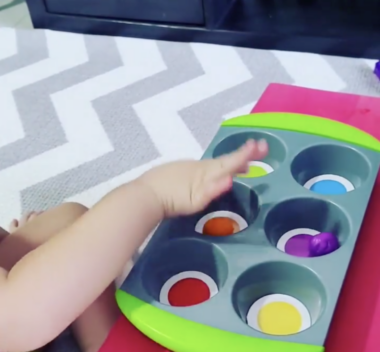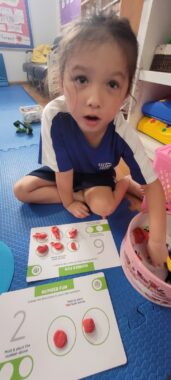Colorful dough can power our children’s play and learning
A timeless toy that helps with fine motor skills and sensory integration

After the dough came out hot from the oven, I added drops of dye into three balls of it. I worked the different colors into the dough to create a favorite and timeless childhood toy that’s been proven valuable for learning, creativity, and sensory integration.
Modeling clay, putty, or colorful dough, best known by the popular Play-Doh toy, might seem like just a gooey, messy substance, but it’s much more. It offers children open-ended activities and multiple developmental benefits, which help in achieving several goals.

Using modeling clay with various tools, Rylae-Ann was able to improve her fine motor skills. (Photo by Richard E. Poulin III)
When we learned our daughter, Rylae-Ann, had aromatic l-amino acid decarboxylase (AADC) deficiency, we found little guidance on how to help her. Fortunately, my wife, Judy, and I are both educators. Our teaching intuition kicked in, and we began looking for ways to support our daughter. Colorful dough was one of the tools we consistently used to enable her progress.
From developing fine motor skills to enhancing cognitive growth, this toy is a versatile educational resource that invites children to explore and play.
Improving fine motor skills
AADC deficiency rendered our daughter unable to move. We didn’t give up hope or let that deter us from helping her, however. We acted as puppeteers to guide our daughter to interact with the dough.
We used Rylae-Ann’s hand to manipulate and shape the clay. Even though some may have thought our goal was impossible, we wanted to help build muscles that would eventually lead her to writing. Playing with dough can be used to develop fine motor skills since similar movements are used to draw and button clothes.
Cognitive and language development
Beyond its tactile benefits, modeling clay can contribute significantly to cognitive growth, most obviously by playing and creating with it. You can use the dough to make patterns or represent math. We used plastic forks and knives to divide the dough or create shapes that we could count together.

Using scented, colored dough with different textures, Rylae-Ann takes part in sensory-integration activities. (Photo by Richard E. Poulin III)
We took this learning further by incorporating singing and games. Regardless of the activity, we engaged Rylae-Ann with a variety of vocabulary and discussions. Play fosters learning language, and the play putty captures the attention of children and adults alike.
Colorful dough is a canvas for the imagination, and it allowed Rylae-Ann to express her creativity. In her AADC deficiency world, she could express very little, so the dough became an essential outlet. Unlike coloring books or building sets with specific instructions, the play putty invites open-ended exploration. Children can dream up and sculpt anything their minds conjure, fostering a sense of agency and originality.
The tactile nature of the dough provides a sensory experience that goes beyond conventional drawing or painting. Children can feel the texture change as they mold it, stimulating their sense of touch and kinesthetic awareness. This sensory-rich play can lead to unique creations and imaginative storytelling, promoting cognitive development alongside creativity.
Emotional and sensory integration

After gene therapy, Rylae-Ann used colorful dough to support learning math. (Photo by Richard E. Poulin III)
The colorful dough seemed to have a magical power that captured Rylae-Ann’s attention. Sometimes, we added swirls of color, sparkles, small beads, or essential oils to the dough. These added a soothing quality that promoted emotional regulation. As soon as Judy or I brought out the modeling clay, Rylae-Ann would giggle with excitement about what was coming her way.
Manipulating the dough can be a therapeutic outlet for stress or frustration. We had to do most of the movements for Rylae-Ann, but she did make small movements with her fingers, which was a big deal for her.
The colorful dough also helped Rylae-Ann experience different textures. As soon as her fingers would touch grass, sand, carpet, or other textured materials, she’d immediately pull away or even start crying. By using the play putty, however, she learned to relax and focus. I’d never have imagined this toy could be used to reduce anxiety.
Sensory integration is a process in which the brain organizes sensory information from the environment, allowing children to understand their surroundings and respond appropriately. Colorful dough makes for a rich activity that can aid this process, especially for children with sensory-processing challenges.
Family fun
The versatility of colorful dough can be enjoyed by all. Even after Rylae-Ann had gene therapy and began to improve, the toy remained a part of many activities. Playing with it is something our entire family enjoys.
The world is offering more technology for children to use, yet we’re learning that too much technology harms young and developing minds. Colorful dough, on the other hand, continues to show timeless, positive benefits for all children. With a few household ingredients, you can be on your way to having fun and sculpting a path for your child’s future.
Note: AADC News is strictly a news and information website about the disease. It does not provide medical advice, diagnosis, or treatment. This content is not intended to be a substitute for professional medical advice, diagnosis, or treatment. Always seek the advice of your physician or other qualified health provider with any questions you may have regarding a medical condition. Never disregard professional medical advice or delay in seeking it because of something you have read on this website. The opinions expressed in this column are not those of AADC News or its parent company, Bionews, and are intended to spark discussion about issues pertaining to aromatic l-amino acid decarboxylase deficiency.








Leave a comment
Fill in the required fields to post. Your email address will not be published.